
ProtoPasta é uma empresa situada nos Estados Unidos da América, de produção de filamentos para impressão 3D de alta qualidade.
Caracterizada pelos rolos feitos em cartão, esta marca é mundialmente famosa por ser especializada em materiais como PLA e ABS modificados com outros materiais, como o PLA Magnético; o PLA Condutivo; PLA de fibra de carbono; HTPLA de cobre, latão ou bronze; ou o ABS-PC.
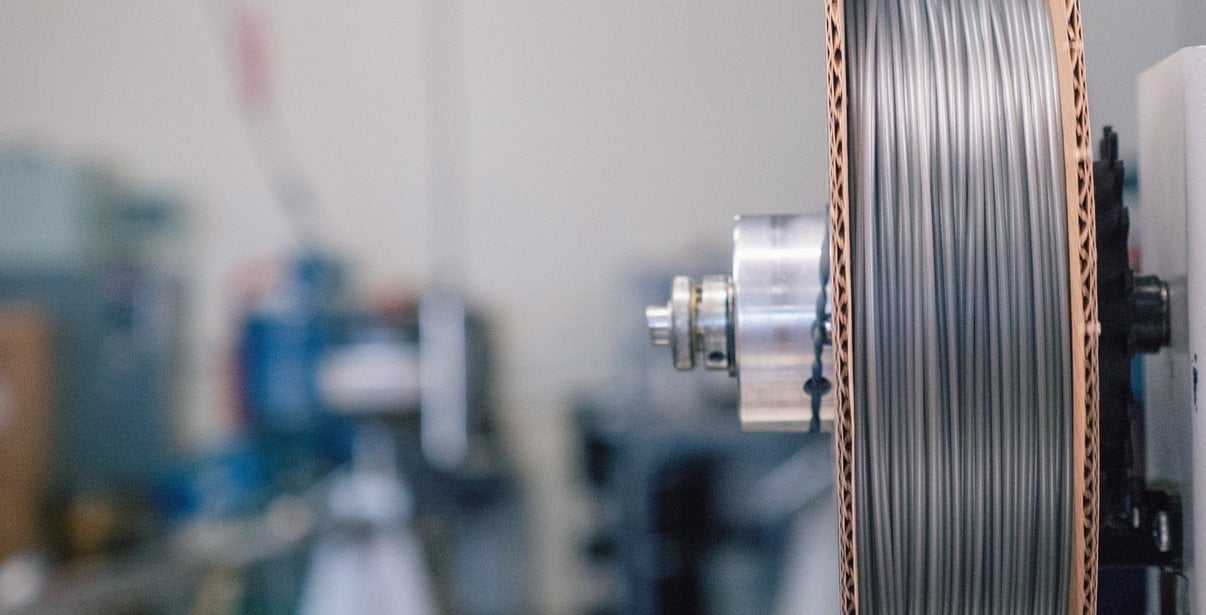
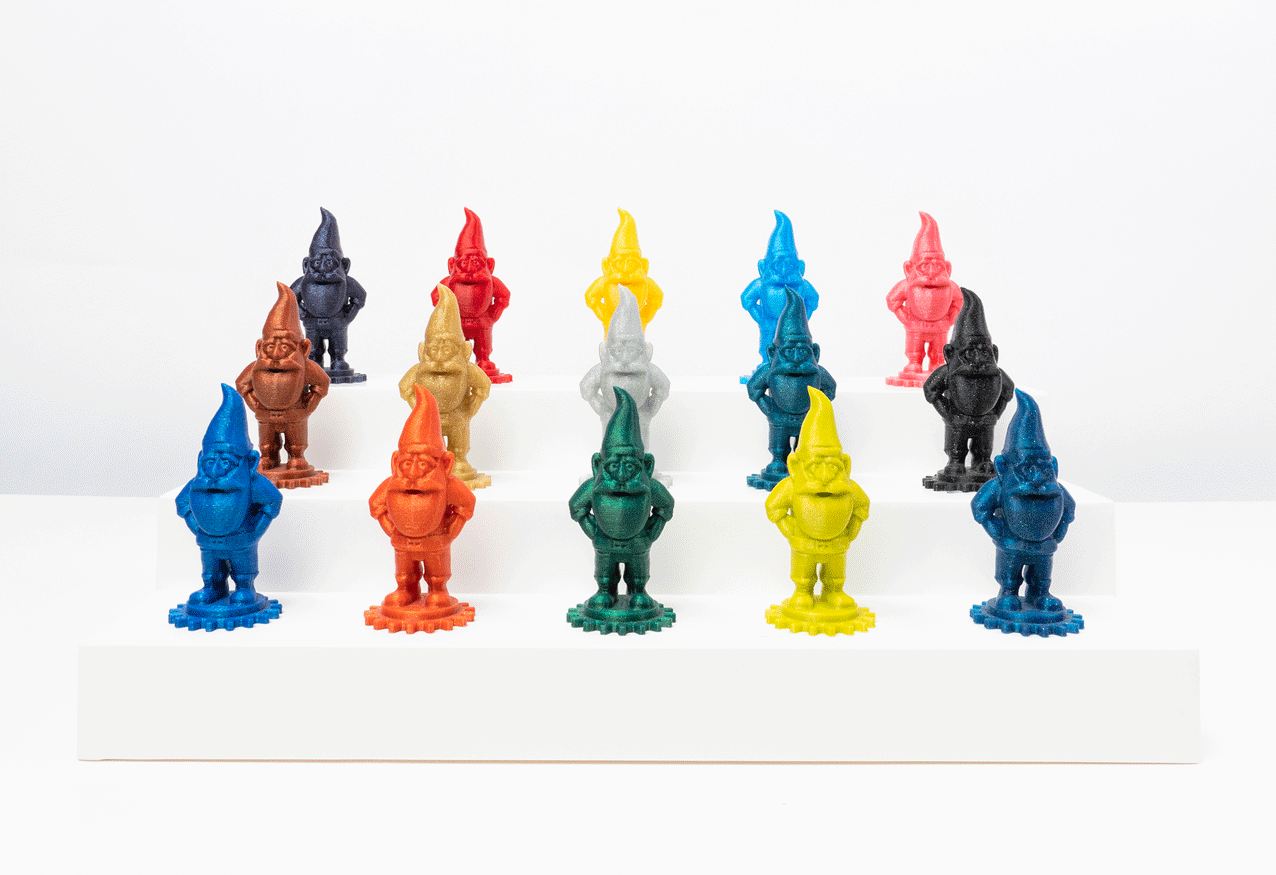
Our most popular exotic material, Proto-pasta Carbon Fiber Composite HTPLA is a combination of milled carbon fibers and high-performance PLA.
Resulting 3D prints made with our Carbon Fiber HTPLA are demonstrably more rigid, providing excellent structural strength and layer adhesion with very low warpage.
The embedded carbon provides a beautiful dark matte gray finish with a slight sheen, resulting in 3D prints with exceptional accuracy, finish, and performance!
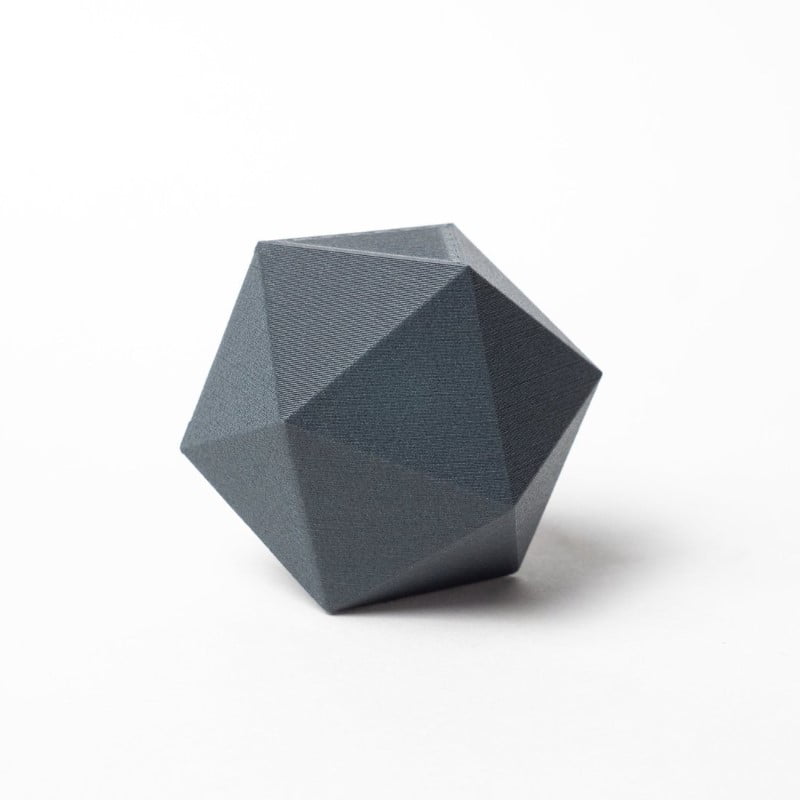
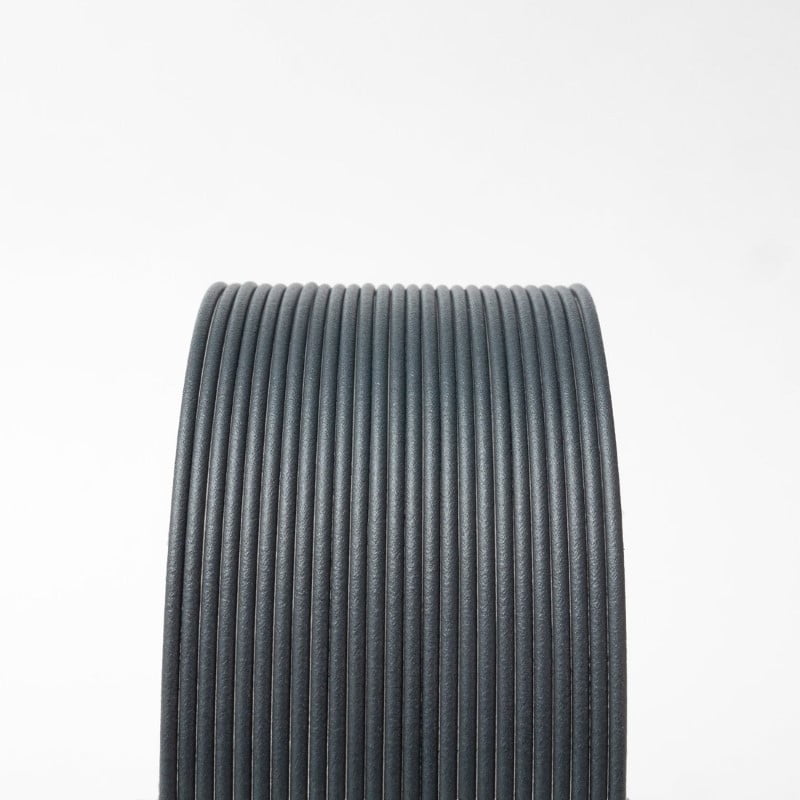
Proto-pasta Carbon Fiber Composite HTPLA is a combination of milled carbon fibers and high-performance PLA. Resulting 3D printed prototypes and end-use parts are characterized by exceptionally stability of form and potential use up to 155 deg C (310 deg F) when heat treated.
Adaptable to most PLA-compatible printers. Heated bed recommended for process ease, quality, and reliability, but not required. Printer should allow 3rd party filament, parameter adjustment, and nozzle replacement. Specialized machine adaptation and maintenance may be required for Proto-pasta materials particularly in continued use of abrasive materials. More on getting started. More about our release of Carbon Fiber HTPLA.
Prop 65 Warning! May cause cancer or reproductive harm.
However, in an effort put this statement in perspective, consider our blog on this subject to better-understand actual risks.
RoHS compliant - does not contain Cadmium (Cd), Lead (Pb), Mercury (Hg), Hexavalent Chromium: (Cr VI), Polybrominated Biphenyls (PBB), Polybrominated Diphenyl Ethers (PBDE), Bis(2-Ethylhexyl) phthalate (DEHP), Benzyl butyl phthalate (BBP), Dibutyl phthalate (DBP), or Diisobutyl phthalate (DIBP)
Regarding food contact - though base resin may be safe for food contact, our process & additional ingredients may not be. Thus our materials are not certified for food contact even if the risk is low. Please consider additional coatings, treatments & testing before pursuing extended food contact or certification.
Regarding skin contact - Not a known skin irritant, however, avoid recommending prolonged skin exposure without further testing.
Some machines may require specific considerations for filament placement, path, adjustments, settings, or other preparation & maintenance.
Abrasive materials like Carbon Fiber and Metal Composites may cause premature wear of in line components such as bowden tubes, drive gears, nozzles, and other items in the filament travel path. Serviceable hardware including replaceable nozzles suggested. Wear resistant nozzles are recommended for extended use. Nozzles wear most quickly with flattening of the tip which affects nozzle diameter & distance to build plate. Inconsistent extrusion, inaccuracy & process instability. Extrusion width & first layer distance adjustments and/or replacement of nozzle. For more on nozzle replacement consider this blog demonstrating nozzle replacement & adjustments on a Prusa MK3. Reduce nozzle wear by minimizing over-extrusion & infill.
Product label suggest temperatures as a guideline based on typical nozzle set points. Appropriate settings can vary widely & in given good conditions, a wide range of temperatures can yield positive results. With relatively low print rates on hardware without hangups, HTPLA prints well at the low side of the recommended range. With high print rates on machines with hardware hangups, higher than labeled temperatures may be required for consistent extrusion. In some cases, oiling filament makes the difference between success & failure.
One specific problematic example is the Prusa MK3 which, by design, has a Prusa-specific heat break with an internal ledge that material can get caught on. To reduce need for nuance & risk of jamming, users should either replace the Prusa-specific heat break with a standard e3d v6 one, oil filament to help it slip past the Prusa-specific ledge, or print at an unusually high temperature. The trade off with high temperature as a solution is you should also match that with a high volume flow rate. Sounds great, right? It's okay except for the loss of detail when having to slow down for small part, fine feature, or high resolution printing.
Prusa MK3-specific, Carbon Fiber HTPLA process recommendations:
Volume flow = extrusion width x layer height x speed in mm.
For example, 0.5 mm extrusion width & 0.2 mm layer height for speed 20-90 mm/s.
Poorly cooled cold sides of all metal hotends can yield a similar result & benefit from similar fixes to the Prusa MK3. Aggressive layer fans not isolated from heat blocks and/or nozzles can make for a jammy combination as well. Finding the balance between enough cooling fan when printing fast & a high enough nozzle set-point can be challenging. More isolated hotends with PTFE liners can allow slower printing with lower set points for more detail with less aggressive layer fan settings. Also, insulating your heater block and/or nozzle with a sock can help avoid unwanted layer fan cooling. Rapid changes in speed or print rate should also be avoided whenever possible.
For more on the subject of printing, consider our getting started guide.
HTPLA is a semi-crystalline grade of PLA optimized for heat treating (also known as annealing or crystallizing) for higher temperature use. Without heat treating, "as printed" amorphous PLA loses significant stiffness (and the thus the ability to retain form) as the material approaches it's relatively low glass transition temperature. Heat treating creates a more crystalline molecular structure for maintaining stiffness to near melting, thus extending the useful range of HTPLA, but crystallization also creates shrinkage. HTPLA parts should be scaled in slicer to compensate for shrinkage when heat treating.
A large range of temperatures & times can yield acceptable results. With translucent grades and thin wall parts like a single wall vase, you can see a visual change from transparent to opaque begin in as little as 3 minutes with a full transition to opaque in 7 minutes. Parts with more mass will take more time. What's important is the core temp and time to ensure a comprehensive change in material structure to crystalline throughout the part.
Here's a demonstration of measuring shrinkage, determining change, and applying compensation in printing. Here's additional demonstration of application of scale, heat treating, and validation of form.
Additional post processes might include sanding or painting. The addition of Carbon Fiber can lend well to ease of sanding and adhesion of coatings like paint, however, there are also additional safety considerations when generating dust through sanding and fumes through coating. Please seek safe practices with appropriate personal protective equipment (PPE) and ventilation.
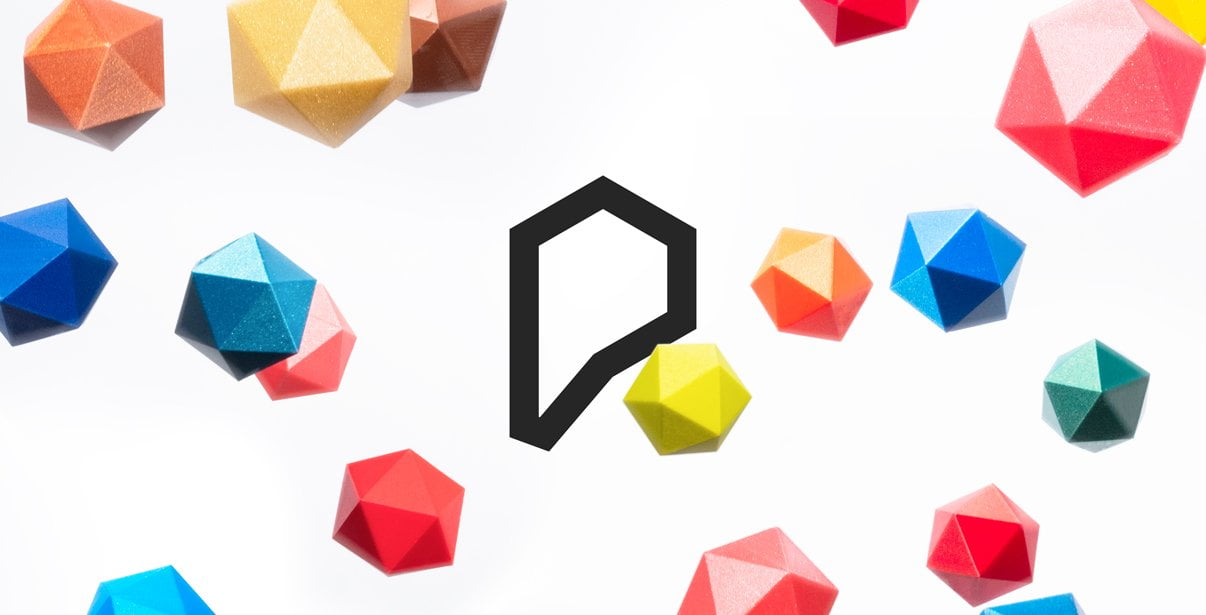
We've created this page to bring you a premium PLA and HTPLA printing experience that rivals our premium material. Follow below to improve your 3D printing experience. In other words, here's your shortcut to awesomeness with pasta. If at the end of this document you have questions or need assistance, please contact us at [email protected].
Loose coils can be very tricky to manage. Going cowboy on your spool handling can quickly end up in a frustrating, tangled mess. Keep your loose coils wrangled with a spool holder like masterspool for a more trouble-free experience. Find out more about loose coil handling in Keith's blog post.
And for spooled filament, never let go of the loose end. When not in the printer extruder, tuck it away in the cardboard spool's corrugation! Also, avoid sharp bends and excessive force when loading filament into your printer.
At Proto-pasta, we make high quality filament. We aspire to make exceptional results easy, but a positive result is very much dependent on your hardware, set-up, adjustments, and process parameters. Matching hardware with process and material for a positive experience is not always straight-forward, but you can start by pairing the following settings with your printer for a good starting point, then tune or troubleshoot as required.
Volume flow rate together with temperature dictates how melted the material is. This is hardware & condition dependent based on hot end, nozzle & extruder type, material & manufacturer as well as layer fan type, position & settings. Extrusion width, layer thickness & speed changes affect volume flow which may change required/desired temperature.
Post your prints & tag us @Proto_pasta on Twitter and Instagram. Need more help? Consider typical pitfalls and fixes below.
We visited Joel and ended up with a helpful video on the subject:
Our most popular exotic material, prints made with our Carbon Fiber PLA are demonstrably more rigid, providing excellent structural strength and layer adhesion with very low warpage. It has a beautiful matte black finish with a slight sheen due to the embedded carbon.
What is it made out of?
Because of the chopped carbon, Protopasta Carbon Fiber PLA may have trouble getting through smaller nozzles. We have had good success using a .5mm nozzle and direct-drive spring loaded pinch-roll style extrusion head.Generally, our customers find it prints just like standard PLA on their machines (at around 195-210° F), though others find success running it a bit hotter (around 220° F). Experiment with your printer and see what works best for you.
Carbon fiber and your printer nozzle
The carbon fibers in our filament are processed for an optimum size: short enough to print in PLA without clogging nozzles, but long enough to provide the added rigidity carbon fiber is famous for. At this length, the chopped carbon fiber makes this filament more abrasive than standard PLA. Prolonged use may result in more wear on your 3D printer, particularly lower-end nozzles.
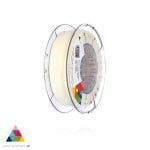
Para uma correcta manutenção da sua impressora 3D, recomendamos sempre que trocar de material de filamento 3D, a efectuar uma purga com filamento especial de limpeza.
Desta forma garante que não ficam vestígios de material nas paredes do nozzle, evitando o acumular de crosta que é criado sempre que efectua trocas de material.
Com este produto evita problema como "clogs" e "jams" e fará com que o seu nozzle mantenha-se sempre limpo, durando muito mais tempo.
Poderá encontrar a partir de 1.49€ no seguinte LINK
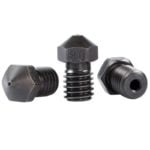
Este material é altamente abrasivo. Recomendamos a utilização de Nozzles de aço endurecido.
Poderá encontrar no seguinte LINK
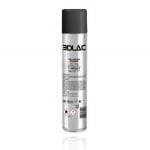
Para obter maior aderência à superfície da sua impressora 3D recomendamos a aplicar 3DLAC na base da plataforma.
Poderá encontrar no seguinte LINK
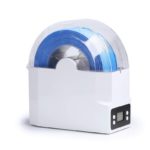
Este material é altamente higroscópico, absorvendo rapidamente a humidade do ar passados poucos minutos após aberto, impossibilitando desta forma a correcta impressão 3D do mesmo. O resultado das impressões 3D de materiais com humidade tendem a ser frágeis e de acabamento irregular ou em certos casos, torna-se simplesmente impossíveis de imprimir.
Deverá de usar soluções de caixas fechadas com dessecante como sílica ou caixas próprias secadoras de filamento.
Poderá encontrar no seguinte LINK
Download:
Technical and Safety Data Sheet
500g- Rolo
HTPLA Dark Gray ( Carbon Fiber Composite ) - Cor
1.75mm (+-0.05mm) - Espessura / Tolerância de diâmetro
Fácil - Facilidade de Impressão

ProtoPasta é uma empresa situada nos Estados Unidos da América, de produção de filamentos para impressão 3D de alta qualidade.
Caracterizada pelos rolos feitos em cartão, esta marca é mundialmente famosa por ser especializada em materiais como PLA e ABS modificados com outros materiais, como o PLA Magnético; o PLA Condutivo; PLA de fibra de carbono; HTPLA de cobre, latão ou bronze; ou o ABS-PC.


The original is still the best! World's First Carbon Fiber PLA filament was kickstarted by ProtoPlant nearly 5 years ago.
Others try, but can't match the quality and ease of printing experience afforded by this product.
Available at a cost low enough for everyday printing, try a mammoth 3kg spool for large format printing!
1.75mm diameter 3kg spools contain more than 1 km of filament! How cool is that?!?!
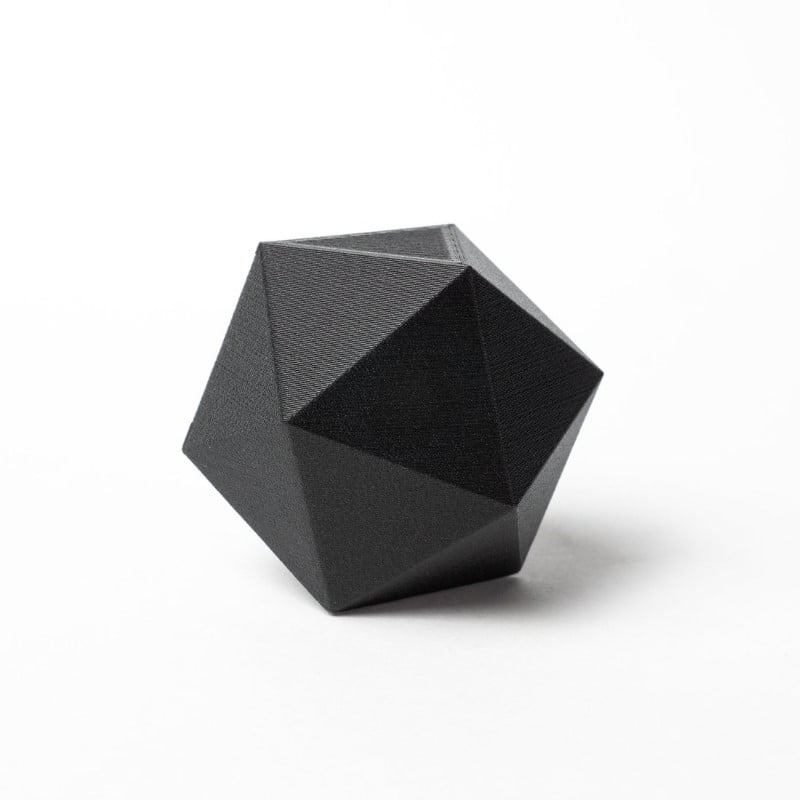

Protopasta Carbon Fiber PLA is based on our easy printing, high quality PLA. Made from the highest quality, dry ingredients and extruded with care in our Washington facility on our own purpose-built extrusion systems. CFPLA prints are demonstrably more rigid with easy processing (often using standard PLA settings) and support removal. Excellent layer adhesion and minimal warpage even without a heated bed make this a great everyday exotic for accurate parts. Layer lines disappear with the beautiful matte black finish. Also has a slight sheen due to the embedded carbon making it very photogenic!
**This filament is slightly more abrasive than standard PLA. Be prepared to replace your nozzle and do 1st layer adjustment after prolonged use or upgrade to a wear resistant nozzle for less maintenance.
In filament form, CFPLA is slightly more brittle than standard PLA, and requires extra care when handling.
Processing is comparable to standard PLA. No heated bed required. Process may be less consistent on smaller nozzles and/or bowden type machines,
We frequently print using direct-drive systems with 0.4mm nozzles and print as high as 240C, though suggest 0.6mm and 210-230C for the best experience.

We've created this page to bring you a premium PLA and HTPLA printing experience that rivals our premium material. Follow below to improve your 3D printing experience. In other words, here's your shortcut to awesomeness with pasta. If at the end of this document you have questions or need assistance, please contact us at [email protected].
Loose coils can be very tricky to manage. Going cowboy on your spool handling can quickly end up in a frustrating, tangled mess. Keep your loose coils wrangled with a spool holder like masterspool for a more trouble-free experience. Find out more about loose coil handling in Keith's blog post.
And for spooled filament, never let go of the loose end. When not in the printer extruder, tuck it away in the cardboard spool's corrugation! Also, avoid sharp bends and excessive force when loading filament into your printer.
At Proto-pasta, we make high quality filament. We aspire to make exceptional results easy, but a positive result is very much dependent on your hardware, set-up, adjustments, and process parameters. Matching hardware with process and material for a positive experience is not always straight-forward, but you can start by pairing the following settings with your printer for a good starting point, then tune or troubleshoot as required.
Volume flow rate together with temperature dictates how melted the material is. This is hardware & condition dependent based on hot end, nozzle & extruder type, material & manufacturer as well as layer fan type, position & settings. Extrusion width, layer thickness & speed changes affect volume flow which may change required/desired temperature.
Post your prints & tag us @Proto_pasta on Twitter and Instagram. Need more help? Consider typical pitfalls and fixes below.
We visited Joel and ended up with a helpful video on the subject:
Our most popular exotic material, prints made with our Carbon Fiber PLA are demonstrably more rigid, providing excellent structural strength and layer adhesion with very low warpage. It has a beautiful matte black finish with a slight sheen due to the embedded carbon.
What is it made out of?
Because of the chopped carbon, Protopasta Carbon Fiber PLA may have trouble getting through smaller nozzles. We have had good success using a .5mm nozzle and direct-drive spring loaded pinch-roll style extrusion head.Generally, our customers find it prints just like standard PLA on their machines (at around 195-210° F), though others find success running it a bit hotter (around 220° F). Experiment with your printer and see what works best for you.
Carbon fiber and your printer nozzle
The carbon fibers in our filament are processed for an optimum size: short enough to print in PLA without clogging nozzles, but long enough to provide the added rigidity carbon fiber is famous for. At this length, the chopped carbon fiber makes this filament more abrasive than standard PLA. Prolonged use may result in more wear on your 3D printer, particularly lower-end nozzles.

Para uma correcta manutenção da sua impressora 3D, recomendamos sempre que trocar de material de filamento 3D, a efectuar uma purga com filamento especial de limpeza.
Desta forma garante que não ficam vestígios de material nas paredes do nozzle, evitando o acumular de crosta que é criado sempre que efectua trocas de material.
Com este produto evita problema como "clogs" e "jams" e fará com que o seu nozzle mantenha-se sempre limpo, durando muito mais tempo.
Poderá encontrar a partir de 1.49€ no seguinte LINK

Este material é altamente abrasivo. Recomendamos a utilização de Nozzles de aço endurecido.
Poderá encontrar no seguinte LINK

Para obter maior aderência à superfície da sua impressora 3D recomendamos a aplicar 3DLAC na base da plataforma.
Poderá encontrar no seguinte LINK

Este material é altamente higroscópico, absorvendo rapidamente a humidade do ar passados poucos minutos após aberto, impossibilitando desta forma a correcta impressão 3D do mesmo. O resultado das impressões 3D de materiais com humidade tendem a ser frágeis e de acabamento irregular ou em certos casos, torna-se simplesmente impossíveis de imprimir.
Deverá de usar soluções de caixas fechadas com dessecante como sílica ou caixas próprias secadoras de filamento.
Poderá encontrar no seguinte LINK
Download:
Technical and Safety Data Sheet
500g- Rolo
PLA The Original ( Carbon Fiber Composite ) - Cor
1.75mm (+-0.05mm) - Espessura / Tolerância de diâmetro
Fácil - Facilidade de Impressão

ProtoPasta é uma empresa situada nos Estados Unidos da América, de produção de filamentos para impressão 3D de alta qualidade.
Caracterizada pelos rolos feitos em cartão, esta marca é mundialmente famosa por ser especializada em materiais como PLA e ABS modificados com outros materiais, como o PLA Magnético; o PLA Condutivo; PLA de fibra de carbono; HTPLA de cobre, latão ou bronze; ou o ABS-PC.


Our most popular exotic material, Protopasta Carbon Fiber Composite HTPLA is a combination of milled carbon fibers and high-performance PLA.
Resulting 3D prints made with our Carbon Fiber HTPLA are demonstrably more rigid, providing excellent structural strength and layer adhesion with very low warpage.
The embedded carbon provides a beautiful matte black finish with a slight sheen, resulting in 3D prints with exceptional accuracy, finish, and performance!
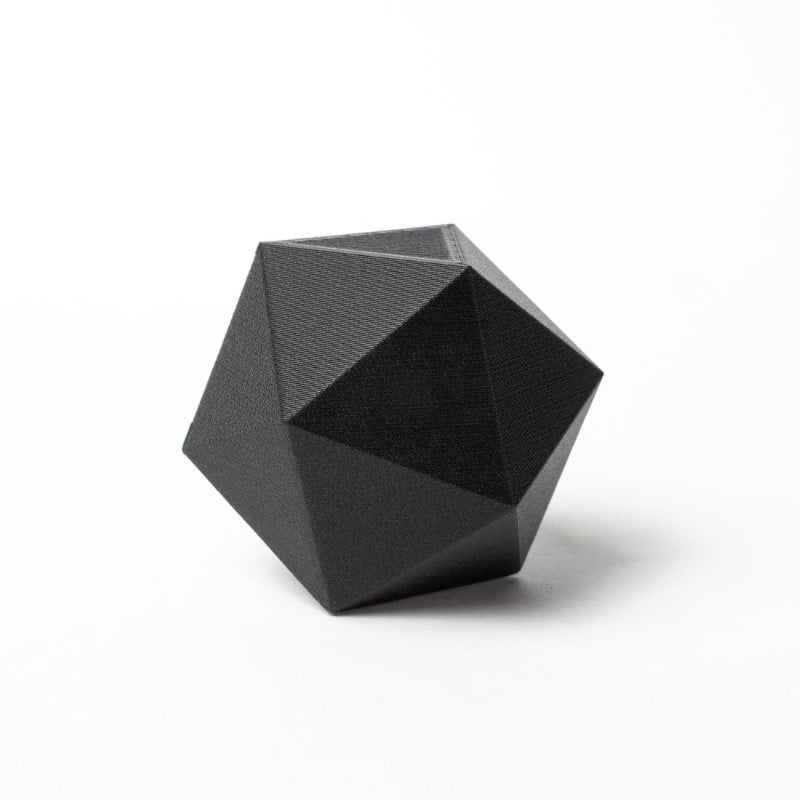

Proto-pasta Carbon Fiber Composite HTPLA is a combination of milled carbon fibers and high-performance, heat treatable PLA (HTPLA). Resulting 3D printed prototypes and end-use parts are characterized by exceptionally stability of form and potential use up to 155 deg C (310 deg F) when heat treated.
Printed parts have a beautiful matte black finish with layer hiding sheen and texture. The carbon fibers give the surface a nice sheen and with layer heights under 0.1mm the layers blend into the texture and almost disappear.
Printed prototypes and end use parts using Protopasta Carbon Fiber HTPLA are characterized by exceptional stability of form and potential use up to 155 deg C (310 deg F) when heat treated. Carbon fiber's rigidity and hardness results in prints with improved form and function compared to standard HTPLA without carbon fibers. Excellent layer adhesion and minimal warpage (even without a heated bed) make this a great everyday filament for accurate parts. Increased rigidity from the carbon fiber means increased structural support but decreased flexibility, making our Carbon Fiber HTPLA an ideal material for frames, supports, shells, propellers, tools... really anything not expected (or desired) to bend. It is particularly loved by drone builders and and RC hobbyists.
Adaptable to most PLA-compatible printers. Heated bed recommended for process ease, quality, and reliability, but not required. Printer should allow 3rd party filament, parameter adjustment, and nozzle replacement. Specialized machine adaptation and maintenance may be required for Proto-pasta materials, particularly in continued use of abrasive materials. Some machines may require specific considerations for filament placement, path, adjustments, settings, or other preparation & maintenance.
Abrasive materials like Carbon Fiber and Metal Composites may cause premature wear of in line components such as bowden tubes, drive gears, nozzles, and other items in the filament travel path. Serviceable hardware including replaceable nozzles suggested. Wear resistant nozzles are recommended for extended use. Nozzles wear most quickly with flattening of the tip which affects nozzle diameter & distance to build plate. Inconsistent extrusion, inaccuracy & process instability. Extrusion width & first layer distance adjustments and/or replacement of nozzle. For more on nozzle replacement consider this blog demonstrating nozzle replacement & adjustments on a Prusa MK3. Reduce nozzle wear by minimizing over-extrusion & infill.
Printed parts using Carbon Fiber HTPLA can be shaved/carved with a sharp blade for a smooth finish. Experiment with weathering or other painting techniques for a unique look. Also, expect improved bonding strength with glue compared to plastic without carbon fiber.
Carbon Fiber HTPLA is optimized for heat treating (also known as annealing or crystallizing) for higher temperature use. Heat treating creates a more crystalline molecular structure for maintaining stiffness to near melting, thus extending the useful range of HTPLA, but crystallization also creates shrinkage. HTPLA parts should be scaled in slicer to compensate for shrinkage when heat treating.
Additional post processes might inlcude sanding or painting. The addition of carbon fiber can lend well to ease of sanding and adhesion of coatings like paint, however, there are also additional safety considerations when generating dust through sanding and fumes through coating. Please seek safe practices with appropriate persona protective (PPE) and ventilation.

We've created this page to bring you a premium PLA and HTPLA printing experience that rivals our premium material. Follow below to improve your 3D printing experience. In other words, here's your shortcut to awesomeness with pasta. If at the end of this document you have questions or need assistance, please contact us at [email protected].
Loose coils can be very tricky to manage. Going cowboy on your spool handling can quickly end up in a frustrating, tangled mess. Keep your loose coils wrangled with a spool holder like masterspool for a more trouble-free experience. Find out more about loose coil handling in Keith's blog post.
And for spooled filament, never let go of the loose end. When not in the printer extruder, tuck it away in the cardboard spool's corrugation! Also, avoid sharp bends and excessive force when loading filament into your printer.
At Proto-pasta, we make high quality filament. We aspire to make exceptional results easy, but a positive result is very much dependent on your hardware, set-up, adjustments, and process parameters. Matching hardware with process and material for a positive experience is not always straight-forward, but you can start by pairing the following settings with your printer for a good starting point, then tune or troubleshoot as required.
Volume flow rate together with temperature dictates how melted the material is. This is hardware & condition dependent based on hot end, nozzle & extruder type, material & manufacturer as well as layer fan type, position & settings. Extrusion width, layer thickness & speed changes affect volume flow which may change required/desired temperature.
Post your prints & tag us @Proto_pasta on Twitter and Instagram. Need more help? Consider typical pitfalls and fixes below.
We visited Joel and ended up with a helpful video on the subject:
Our most popular exotic material, prints made with our Carbon Fiber PLA are demonstrably more rigid, providing excellent structural strength and layer adhesion with very low warpage. It has a beautiful matte black finish with a slight sheen due to the embedded carbon.
What is it made out of?
Because of the chopped carbon, Protopasta Carbon Fiber PLA may have trouble getting through smaller nozzles. We have had good success using a .5mm nozzle and direct-drive spring loaded pinch-roll style extrusion head.Generally, our customers find it prints just like standard PLA on their machines (at around 195-210° F), though others find success running it a bit hotter (around 220° F). Experiment with your printer and see what works best for you.
Carbon fiber and your printer nozzle
The carbon fibers in our filament are processed for an optimum size: short enough to print in PLA without clogging nozzles, but long enough to provide the added rigidity carbon fiber is famous for. At this length, the chopped carbon fiber makes this filament more abrasive than standard PLA. Prolonged use may result in more wear on your 3D printer, particularly lower-end nozzles.

Para uma correcta manutenção da sua impressora 3D, recomendamos sempre que trocar de material de filamento 3D, a efectuar uma purga com filamento especial de limpeza.
Desta forma garante que não ficam vestígios de material nas paredes do nozzle, evitando o acumular de crosta que é criado sempre que efectua trocas de material.
Com este produto evita problema como "clogs" e "jams" e fará com que o seu nozzle mantenha-se sempre limpo, durando muito mais tempo.
Poderá encontrar a partir de 1.49€ no seguinte LINK

Este material é altamente abrasivo. Recomendamos a utilização de Nozzles de aço endurecido.
Poderá encontrar no seguinte LINK

Para obter maior aderência à superfície da sua impressora 3D recomendamos a aplicar 3DLAC na base da plataforma.
Poderá encontrar no seguinte LINK

Este material é altamente higroscópico, absorvendo rapidamente a humidade do ar passados poucos minutos após aberto, impossibilitando desta forma a correcta impressão 3D do mesmo. O resultado das impressões 3D de materiais com humidade tendem a ser frágeis e de acabamento irregular ou em certos casos, torna-se simplesmente impossíveis de imprimir.
Deverá de usar soluções de caixas fechadas com dessecante como sílica ou caixas próprias secadoras de filamento.
Poderá encontrar no seguinte LINK
Download:
Technical and Safety Data Sheet
500g- Rolo
HTPLA Black ( Carbon Fiber Composite ) - Cor
1.75mm (+-0.05mm) - Espessura / Tolerância de diâmetro
Fácil - Facilidade de Impressão
EXCELÊNCIA DAS FIBRAS DE CARBONO
PA12+CF15 a marca Fiberlogy é mais uma manifestação das capacidades técnicas do filamento Nylon PA12 que foi reforçado com 15% de adição de fibras de carbono.
Caracteriza-se por alta resistência térmica e menos encolhimento em comparação com o Nylon PA12 não modificado.
A aplicação da fibra de carbono permite reduzir o peso do componente, mantendo a sua elevada rigidez estrutural.
O PA12+CF tem uma gama de aplicações em todo o sector, incluindo os sectores automóvel e de engenharia, sendo perfeito para a criação de protótipos avançados, drones e produtos finais que exigem uma maior durabilidade, reduzindo ao mesmo tempo o seu peso.
Aplicação:
PA12 + CF15
Propriedades:
Como imprimir?

Este material é altamente abrasivo. Recomendamos a utilização de Nozzles de aço endurecido.
Poderá encontrar no seguinte LINK
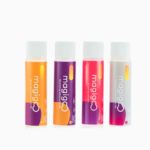
Este material é considerado de difícil aderência à superfície da plataforma de impressão 3D de vidro ou PEI. Para evitar problemas de warpping e de aderência das peças, recomendamos a aplicar potenciador de aderência especial para PA Nylon.
Poderá encontrar no seguinte LINK

Normalmente os filamentos Nylon são altamente higroscópicos, absorvendo rapidamente a humidade do ar passados poucos minutos após abertos, impossibilitando desta forma a correcta impressão 3D do mesmos. O resultado das impressões 3D de materiais com humidade tendem a ser frágeis e de acabamento irregular ou em certos casos, torna-se simplesmente impossíveis de imprimir.
Deverá de usar soluções de caixas fechadas com dessecante como sílica ou caixas próprias secadoras de filamento. AVISO: O recurso a forno para secagem do filamento invalida a garantia.
Poderá encontrar no seguinte LINK
Download:
Technical Data Sheet
Material Safety Data Sheet
Amostra (10m +- 30g) - Rolo
PA12+CF15 Black - Cor
1.75mm (+-0.05mm) - Espessura / Tolerância de diâmetro
+0.01mm - Tolerância Oval
255º a 270º - Temp. recomendada do Hotend
40º a 110º - Temp. recomendada da Heated bed (mediante aplicação de Magigoo PA)
Difícil - Facilidade de Impressão

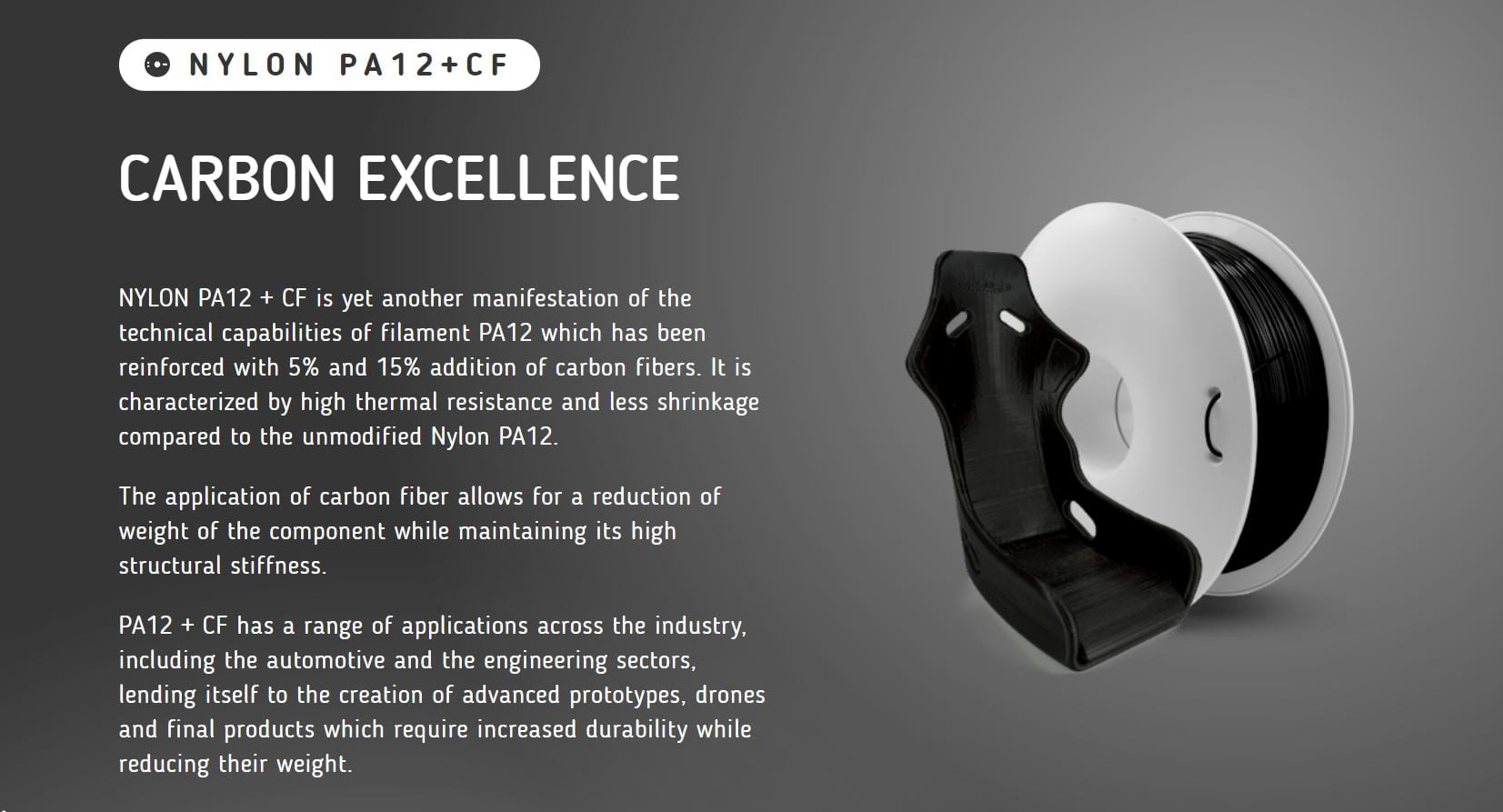
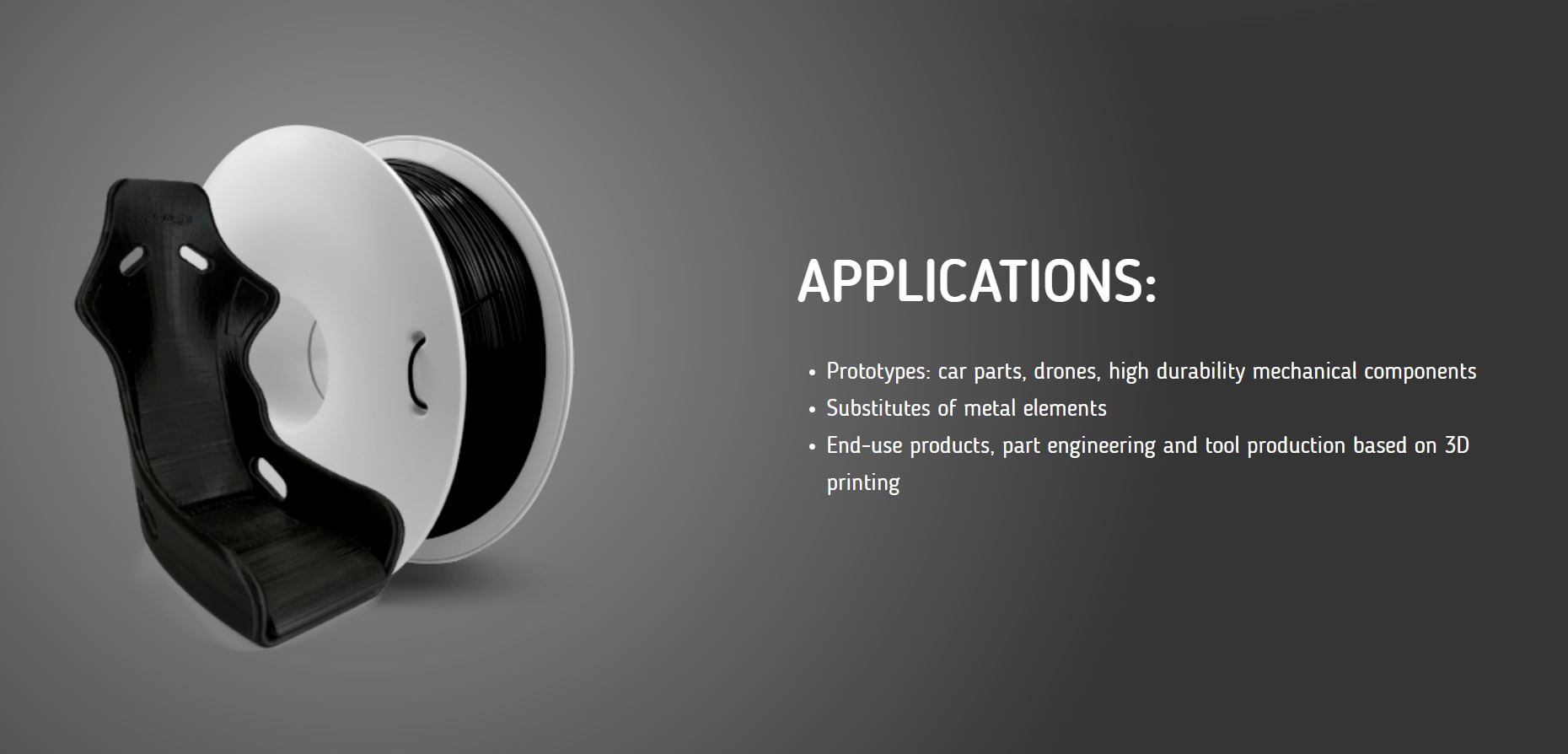
EXCELÊNCIA DAS FIBRAS DE CARBONO
PA12+CF15 a marca Fiberlogy é mais uma manifestação das capacidades técnicas do filamento Nylon PA12 que foi reforçado com 15% de adição de fibras de carbono.
Caracteriza-se por alta resistência térmica e menos encolhimento em comparação com o Nylon PA12 não modificado.
A aplicação da fibra de carbono permite reduzir o peso do componente, mantendo a sua elevada rigidez estrutural.
O PA12+CF tem uma gama de aplicações em todo o sector, incluindo os sectores automóvel e de engenharia, sendo perfeito para a criação de protótipos avançados, drones e produtos finais que exigem uma maior durabilidade, reduzindo ao mesmo tempo o seu peso.
Aplicação:
PA12 + CF15
Propriedades:
Como imprimir?

Este material é altamente abrasivo. Recomendamos a utilização de Nozzles de aço endurecido.
Poderá encontrar no seguinte LINK

Este material é considerado de difícil aderência à superfície da plataforma de impressão 3D de vidro ou PEI. Para evitar problemas de warpping e de aderência das peças, recomendamos a aplicar potenciador de aderência especial para PA Nylon.
Poderá encontrar no seguinte LINK

Normalmente os filamentos Nylon são altamente higroscópicos, absorvendo rapidamente a humidade do ar passados poucos minutos após abertos, impossibilitando desta forma a correcta impressão 3D do mesmos. O resultado das impressões 3D de materiais com humidade tendem a ser frágeis e de acabamento irregular ou em certos casos, torna-se simplesmente impossíveis de imprimir.
Deverá de usar soluções de caixas fechadas com dessecante como sílica ou caixas próprias secadoras de filamento. AVISO: O recurso a forno para secagem do filamento invalida a garantia.
Poderá encontrar no seguinte LINK
Download:
Technical Data Sheet
Material Safety Data Sheet
500g - Rolo
PA12+CF15 Black - Cor
2.85mm (+-0.05mm) - Espessura / Tolerância de diâmetro
+0.01mm - Tolerância Oval
255º a 270º - Temp. recomendada do Hotend
40º a 110º - Temp. recomendada da Heated bed (mediante aplicação de Magigoo PA)
Difícil - Facilidade de Impressão



O PLA+CF da Fiberlogy é um filamento para impressão 3D reforçado com 10% de fibras de carbono, oferecendo propriedades superiores em comparação com o PLA standard. Este material proporciona maior rigidez e resistência mecânica, tornando-o adequado para uma gama mais ampla de aplicações práticas.
O filamento mantém boa estabilidade dimensional e apresenta mínima retração, garantindo uma reprodução precisa dos detalhes projetados. O seu acabamento característico, com superfície mate, disfarça eficazmente as camadas da impressão, conferindo às peças um aspeto visualmente mais agradável.
Devido à natureza abrasiva das fibras de carbono, recomenda-se a utilização de bicos endurecidos durante a impressão. Embora mantenha a facilidade de utilização típica do PLA, este material oferece propriedades reforçadas para a criação de componentes técnicos com maior durabilidade.
Isto faz do PLA+CF uma escolha valiosa para utilizadores que procuram soluções fiáveis para os seus projetos, sem necessidade de recorrer a materiais mais avançados, como o nylon reforçado com fibra de carbono.
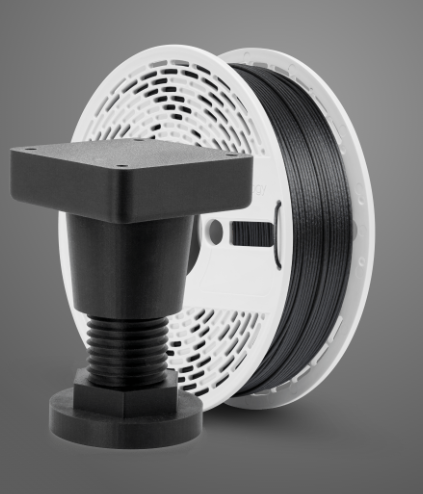
PEÇAS DE SUBSTITUIÇÃO
Componentes de máquinas, dispositivos, veículos e equipamentos eletrónicos.
MODELISMO
Elementos estruturais de modelos, caixas de equipamento, estruturas de drones, suportes para câmaras, suportes e fixações.
PRODUTOS FINAIS
Produção em pequena escala e prototipagem de componentes funcionais.
DESPORTO
Acessórios personalizados para bicicletas e proteções para equipamento desportivo.
Modelo apresentado: Chassis 1/10 Adaptável – DKS-Basic, por Duke Doks via dukedoks.com
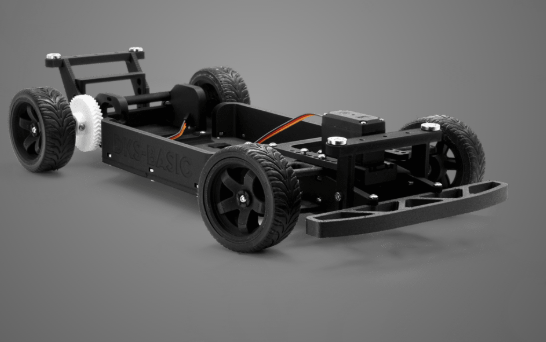

Os seguintes parâmetros são apenas sugestões de definições de impressão para este material.
Para garantir a melhor qualidade de impressão, é necessário ajustar as configurações de acordo com a impressora e as condições de impressão específicas.
| Parâmetro | Valor |
|---|---|
| Temperatura do bico | 210–230 °C |
| Temperatura da cama | 60 °C |
| Câmara fechada | não necessária |
| Ventoinha | 100% |
| Flowrate | 95–105% |
| Velocidade de impressão | < 150 mm/s |
| Condições de secagem | 50 °C / 6h |
| Notas | O material possui propriedades altamente abrasivas. Recomenda-se a utilização de bicos em aço endurecido ou de rubi. Usar luvas (há possibilidade de microdanos na pele). Utilizar máscara de pó e óculos de proteção durante o manuseamento. |
| Perfis |
850g - Rolo
PLA + CF - Black
1.75mm (+-0.05mm) - Espessura / Tolerância de diâmetro
+0.01mm - Tolerância Oval
60º - Temp. recomendada do Hotend
210º a 230º - Temp. recomendada da Heated bed
Moderado - Facilidade de Impressão
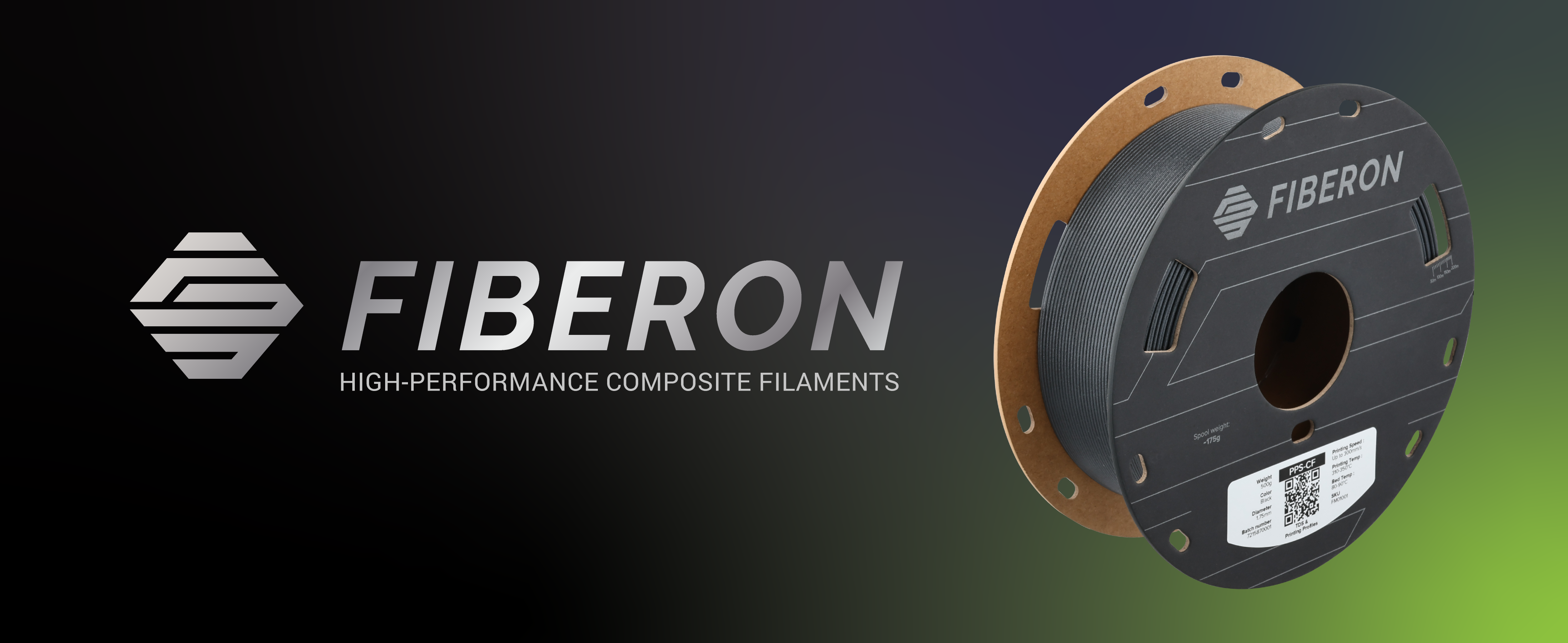
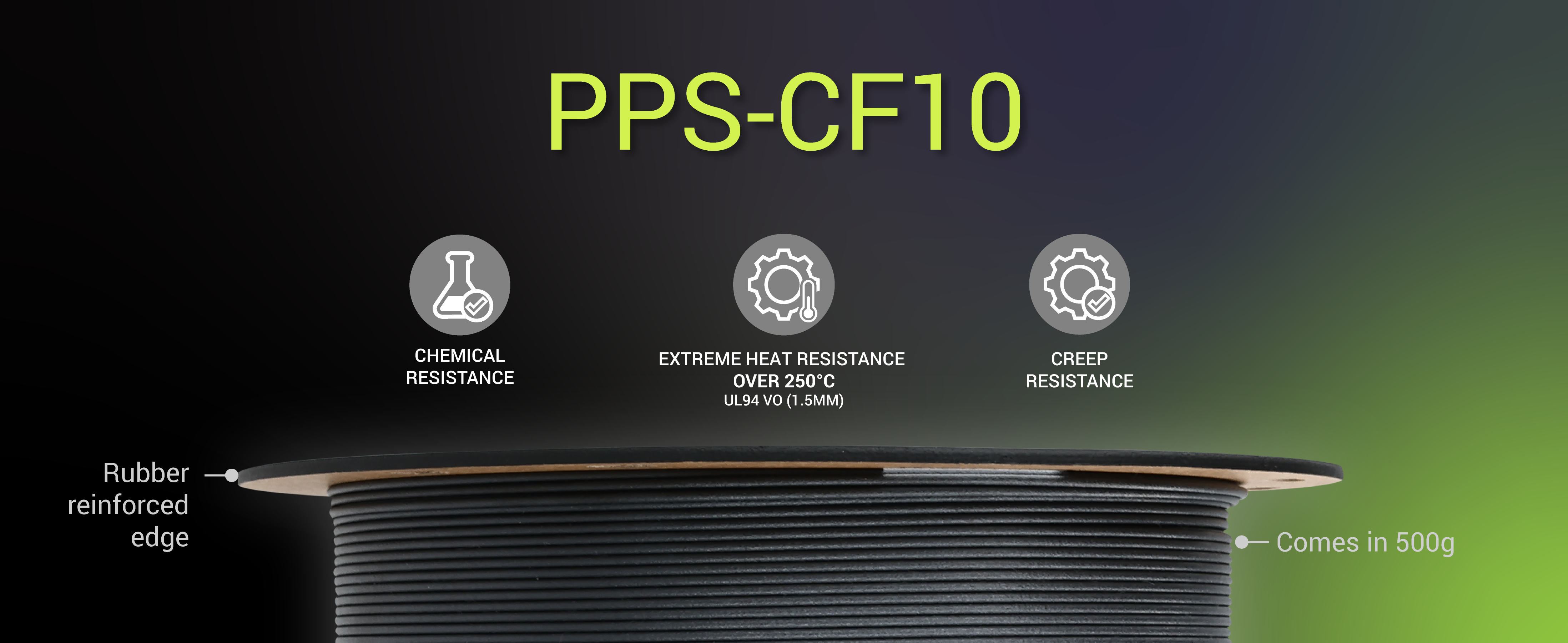
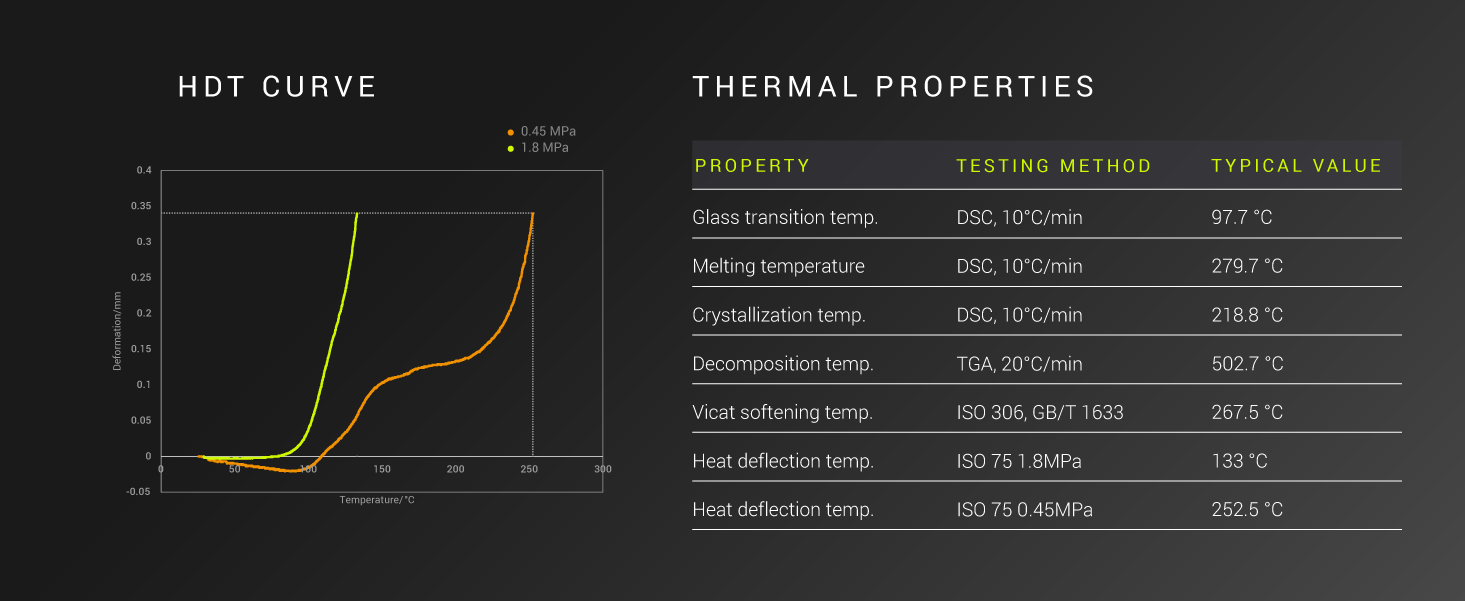
Fiberon™ PPS-CF10 é um filamento de PPS (Polifenileno Sulfeto) reforçado com 10% de fibra de carbono, que apresenta uma deformação mínima durante a impressão, elevada resistência mecânica, excelente resistência ao calor e aos químicos, e dispensa o uso de câmara aquecida.
Com excecional retardância à chama (V0) e insensibilidade à humidade, foi especificamente desenvolvido para profissionais que operam em condições extremas.
Densidade: 1,29 g/cm³
Bobina de cartão 0,5 kg:
Bobina de cartão 0,75 kg:
Bobina de cartão 1 kg:
Bobina de cartão 2 kg:
Bobina de cartão 3 kg:
Bobina de plástico 5 kg:
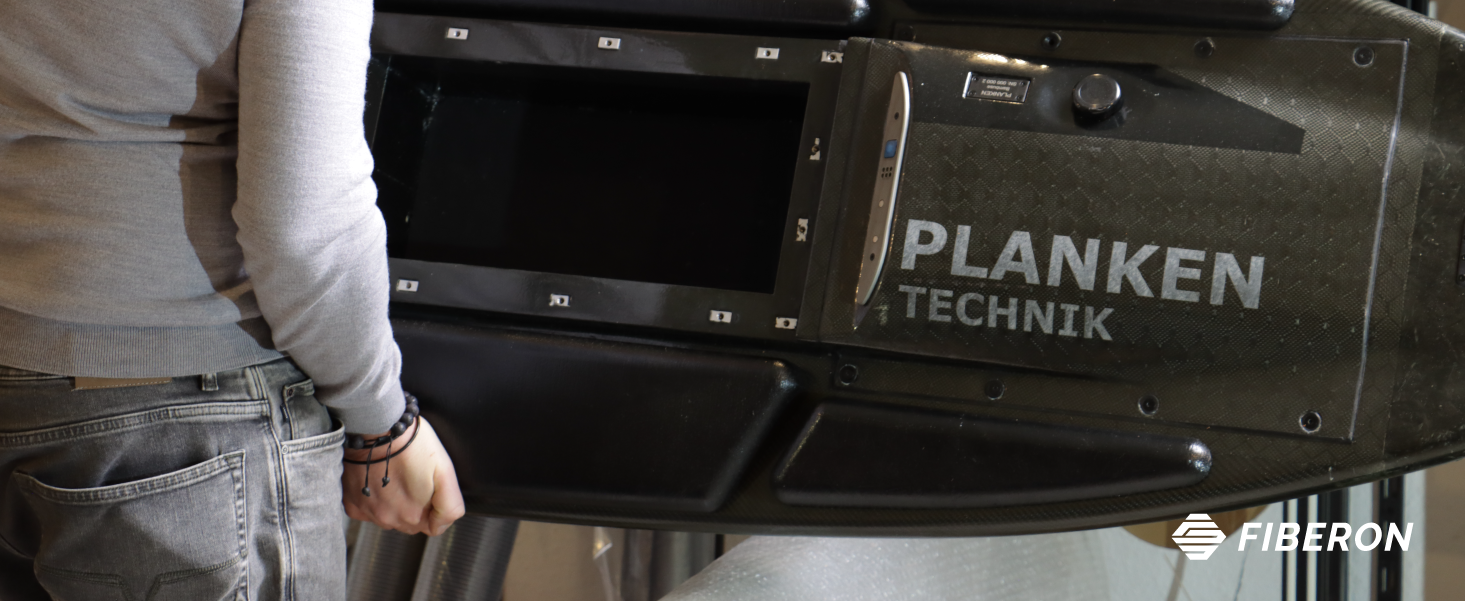
Aqui está a tradução para português de Portugal:
Extrusor direto:
Extrusor Bowden (indireto):
(Apenas se o material tiver absorvido humidade)
Sim – recomendamos vivamente o uso de um hotend que atinja pelo menos 310 °C.
É possível imprimir a 300 °C, mas será necessário imprimir muito lentamente, e corres o risco de ter má adesão entre camadas.
Sim – PPS-CF é naturalmente frágil na bobina e pode partir-se com facilidade.
Recomendamos garantir um caminho limpo e direto até ao extrusor, evitando curvas apertadas e torções.
Podes saber mais sobre o processo de recozimento AQUI.
Embora as bobinas rolem corretamente no AMS, o PPS-CF é muito frágil na bobina.
Se o filamento for sujeito a curvas ou torções apertadas dentro do AMS, pode partir-se facilmente.
Por isso, não recomendamos o uso com AMS – o ideal é ter um caminho direto até à impressora.
Infelizmente, não oferecemos bobinas de 1 kg do Fiberon™.
Isto deve-se ao maior risco de rutura dos filamentos com fibra de carbono ou fibra de vidro, que são mais frágeis.
Estes filamentos são enrolados em bobinas com um núcleo maior, para reduzir o stress no material.
No entanto, isso faz com que 1 kg de filamento não caiba numa bobina tradicional de 1 kg.
3kg- Rolo
Fiberon PPS-CF10 - Black
1.75mm (+-0.05mm) - Espessura / Tolerância de diâmetro
310º a 350º - Temp. recomendada do Hotend
80º a 90º - Temp. recomendada da Heated bed (0ºC mediante aplicação de 3DLAC)
Fácil - Facilidade de Impressão
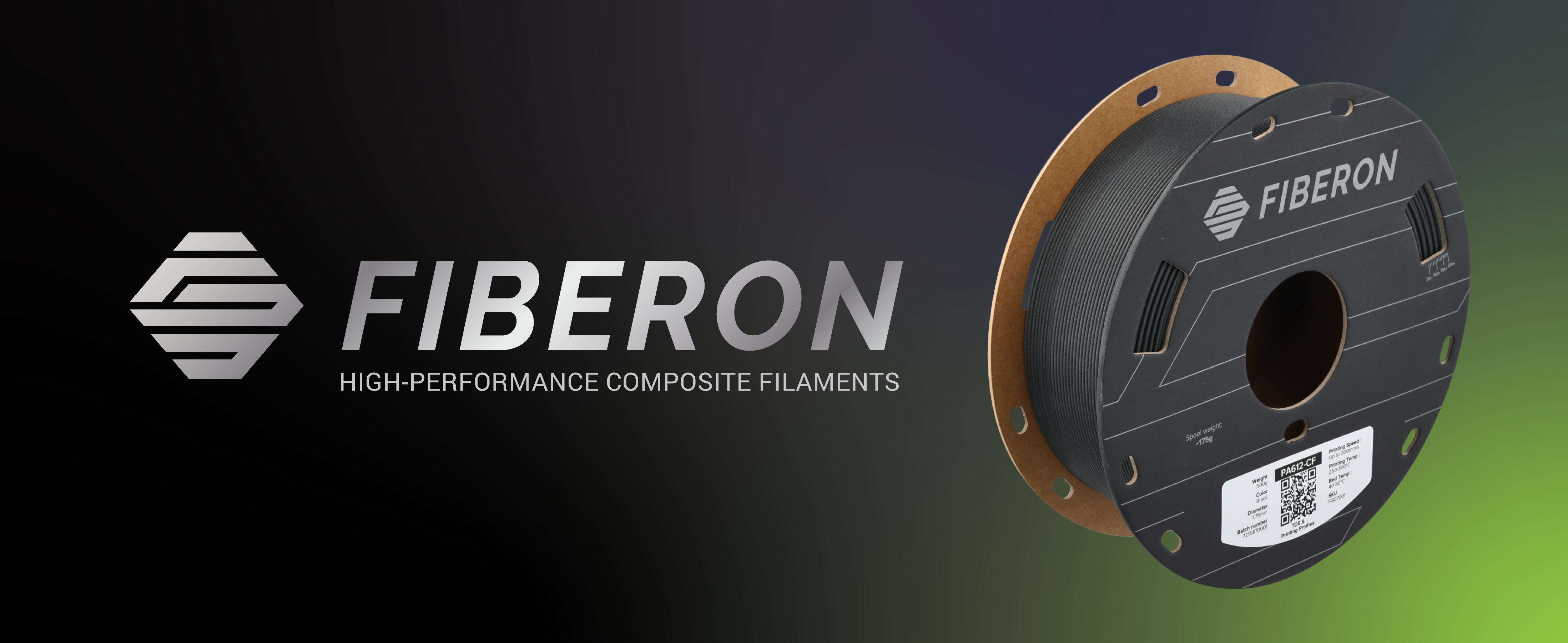
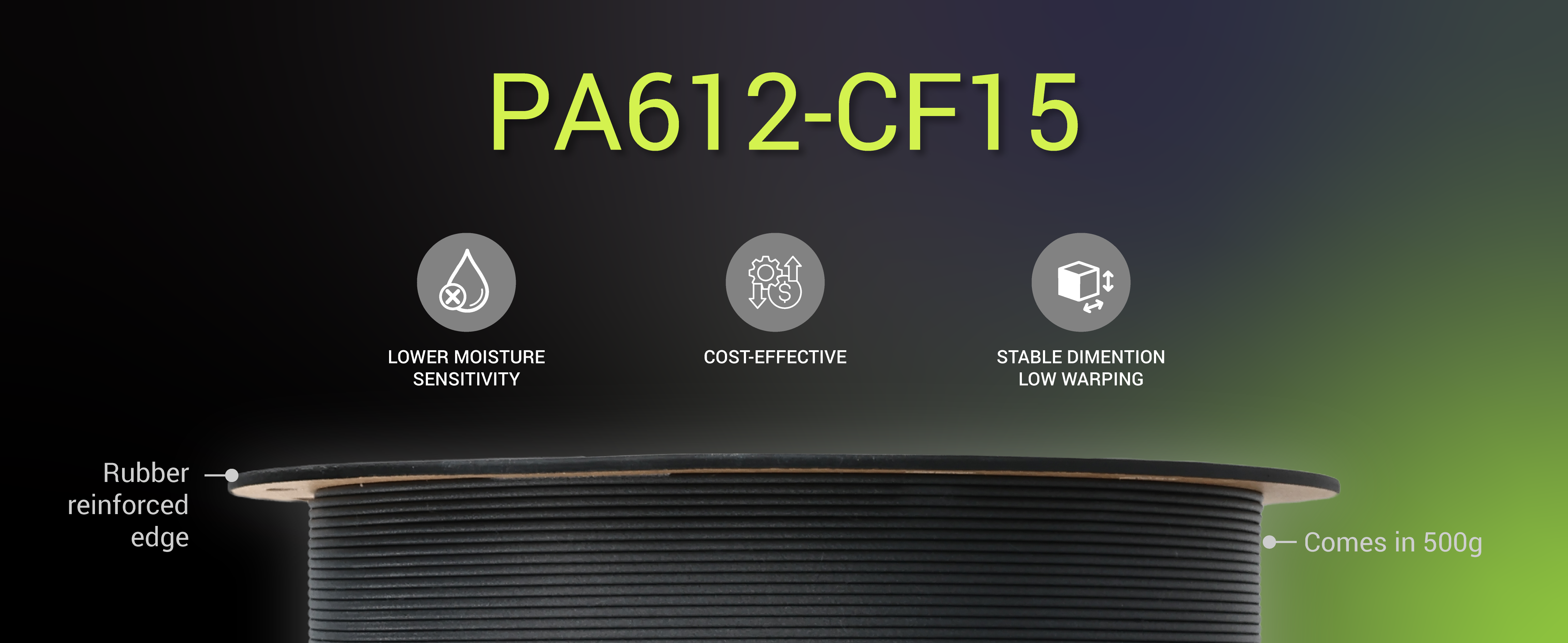
Fiberon™ PA612-CF15 é um filamento à base de copoli-imida de cadeia longa reforçado com fibra de carbono. Graças à sua estrutura química, este material possui uma menor sensibilidade à humidade comparativamente aos materiais à base de PA6/66 e PA6, apresentando também melhores propriedades mecânicas do que os materiais à base de PA12. Além disso, o reforço com fibra de carbono e a tecnologia Warpfree™ melhoram significativamente a estabilidade dimensional das impressões realizadas com este filamento.
O Fiberon™ PA612-CF15 utiliza a mesma fórmula comprovada do PolyMide PA612-CF, embora o Fiberon™ PA612-CF15 possa imprimir num tom de preto ligeiramente mais escuro do que o seu antecessor.
Densidade: 1,03 g/cm³
Requisitos de Impressão
Temperatura do extrusor: 250˚C - 300˚C
Temperatura da mesa (build plate): 40˚C - 50˚C
Temperatura da câmara: Temperatura ambiente
Velocidade de impressão: até 300 mm/s
Ventoinha de arrefecimento: DESLIGADA
Extrusão direta (Direct Drive):
Distância de retração: 3 mm
Velocidade de retração: 40 mm/s
Extrusão indireta (Bowden):
Distância de retração: 6 mm
Velocidade de retração: 60 mm/s
Forno convencional: 100˚C durante 10h
PolyDryer™: Nível 3 durante 18h
100˚C durante 16h
Não encontra o perfil para a sua impressora? Junte-se ao nosso Discord e veja se a comunidade já criou um!
Podes saber mais sobre o tratamento térmico (annealing) AQUI.
O condicionamento por humidade refere-se ao processo de permitir que a peça impressa absorva humidade. Isto é inevitável, uma vez que as poliamidas (nylons) são higroscópicas. Podes acelerar este processo mantendo a peça num ambiente com humidade elevada ou submergindo-a em água durante 48 horas. Todos os nossos testes foram realizados com peças sujeitas a tratamento térmico a 100˚C durante 16 horas, e posteriormente submersas em água a 60˚C durante 48 horas. O teor médio de humidade das peças após este processo é de 2,57%.
Ao realizar o tratamento térmico num forno de convecção, a peça ficará seca. Portanto, se fizeres o condicionamento antes do tratamento térmico, terás de repetir o condicionamento depois. Recomendamos, assim, fazer o condicionamento por humidade apenas após o tratamento térmico.
Os nossos nylons incluem a tecnologia Warp-Free™. Para que esta tecnologia funcione corretamente, é essencial que tanto a mesa como o ambiente estejam abaixo dos 50˚C durante a impressão. Posteriormente, é feito o tratamento térmico para garantir a resistência máxima da peça.
Sabe mais AQUI.
Sim! Redesenhámos as bordas das nossas bobinas, por isso todos os produtos Polymaker funcionam perfeitamente na AMS.
Ainda assim, deves ter atenção extra quando utilizares materiais abrasivos na AMS.
Infelizmente não disponibilizamos bobinas Fiberon™ de 1 kg. Isto deve-se ao risco acrescido de quebra do filamento de fibra de carbono e fibra de vidro quando armazenado em bobinas maiores.
Uma vez que estes filamentos são mais frágeis, utilizamos uma bobina com núcleo maior. Este núcleo maior significa que 1 kg de filamento não caberia numa bobina típica de 1 kg.
3kg- Rolo
Fiberon PA612-CF15 - Black
1.75mm (+-0.05mm) - Espessura / Tolerância de diâmetro
250º a 300º - Temp. recomendada do Hotend
40º a 50º - Temp. recomendada da Heated bed (0ºC mediante aplicação de 3DLAC)
Fácil - Facilidade de Impressão



Fiberon™ PPS-CF10 é um filamento de PPS (Polifenileno Sulfeto) reforçado com 10% de fibra de carbono, que apresenta uma deformação mínima durante a impressão, elevada resistência mecânica, excelente resistência ao calor e aos químicos, e dispensa o uso de câmara aquecida.
Com excecional retardância à chama (V0) e insensibilidade à humidade, foi especificamente desenvolvido para profissionais que operam em condições extremas.
Densidade: 1,29 g/cm³
Bobina de cartão 0,5 kg:
Bobina de cartão 0,75 kg:
Bobina de cartão 1 kg:
Bobina de cartão 2 kg:
Bobina de cartão 3 kg:
Bobina de plástico 5 kg:

Aqui está a tradução para português de Portugal:
Extrusor direto:
Extrusor Bowden (indireto):
(Apenas se o material tiver absorvido humidade)
Sim – recomendamos vivamente o uso de um hotend que atinja pelo menos 310 °C.
É possível imprimir a 300 °C, mas será necessário imprimir muito lentamente, e corres o risco de ter má adesão entre camadas.
Sim – PPS-CF é naturalmente frágil na bobina e pode partir-se com facilidade.
Recomendamos garantir um caminho limpo e direto até ao extrusor, evitando curvas apertadas e torções.
Podes saber mais sobre o processo de recozimento AQUI.
Embora as bobinas rolem corretamente no AMS, o PPS-CF é muito frágil na bobina.
Se o filamento for sujeito a curvas ou torções apertadas dentro do AMS, pode partir-se facilmente.
Por isso, não recomendamos o uso com AMS – o ideal é ter um caminho direto até à impressora.
Infelizmente, não oferecemos bobinas de 1 kg do Fiberon™.
Isto deve-se ao maior risco de rutura dos filamentos com fibra de carbono ou fibra de vidro, que são mais frágeis.
Estes filamentos são enrolados em bobinas com um núcleo maior, para reduzir o stress no material.
No entanto, isso faz com que 1 kg de filamento não caiba numa bobina tradicional de 1 kg.
500g- Rolo
Fiberon PPS-CF10 - Black
1.75mm (+-0.05mm) - Espessura / Tolerância de diâmetro
310º a 350º - Temp. recomendada do Hotend
80º a 90º - Temp. recomendada da Heated bed (0ºC mediante aplicação de 3DLAC)
Fácil - Facilidade de Impressão
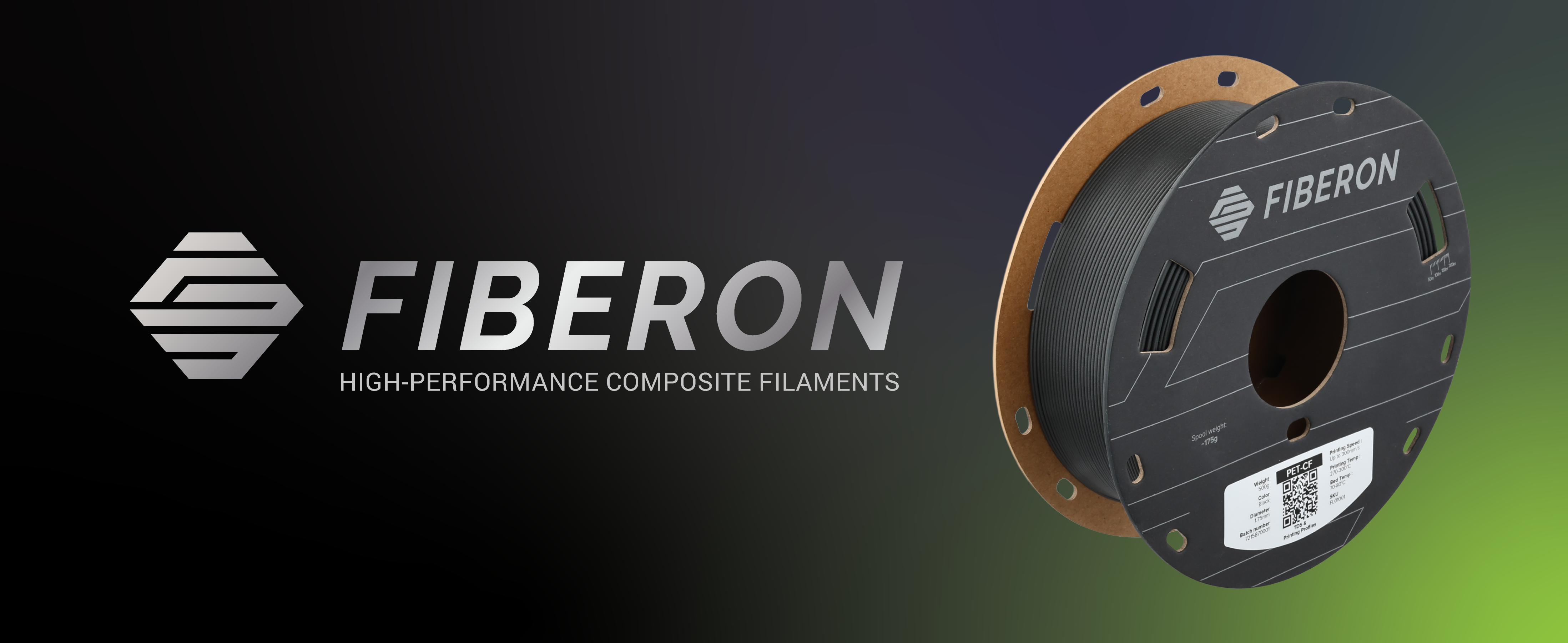
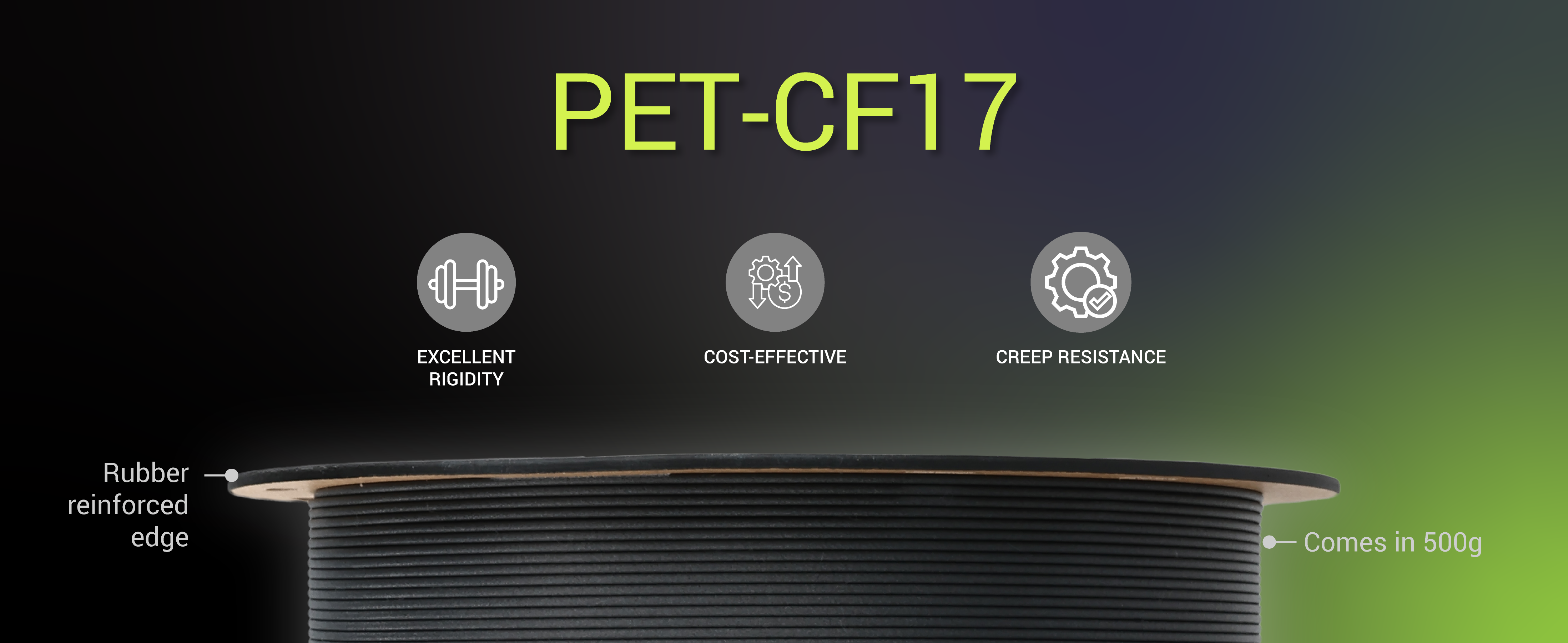
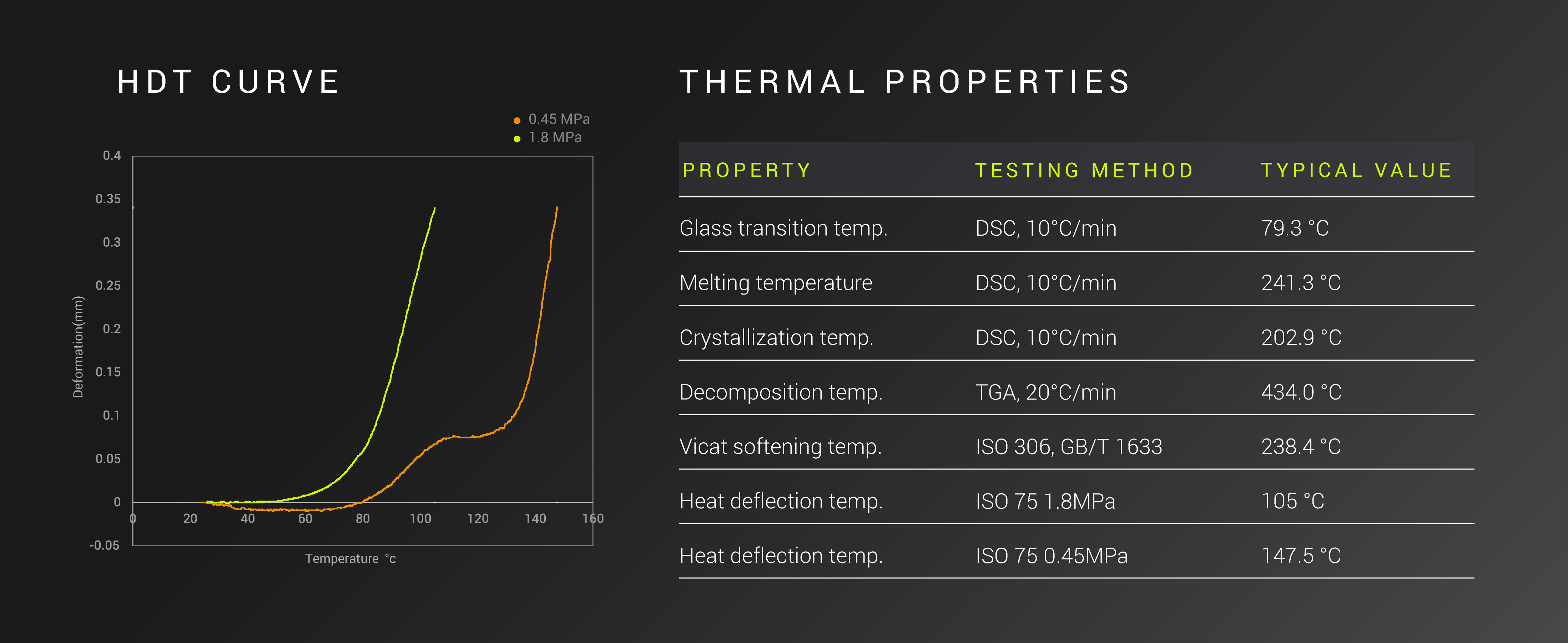
Fiberon™ PET-CF17 é um filamento de PET (polietileno tereftalato) reforçado com 17% de fibra de carbono. É a escolha preferida para impressão 3D de materiais compósitos de engenharia, oferecendo elevado módulo de elasticidade, resistência ao calor, insensibilidade à humidade e facilidade de impressão.
Densidade: 1,34 g/cm³
Bobina de cartão 0,5 kg:
Bobina de cartão 0,75 kg:
Bobina de cartão 1 kg:
Bobina de cartão 2 kg:
Bobina de cartão 3 kg:
Bobina de plástico 5 kg:
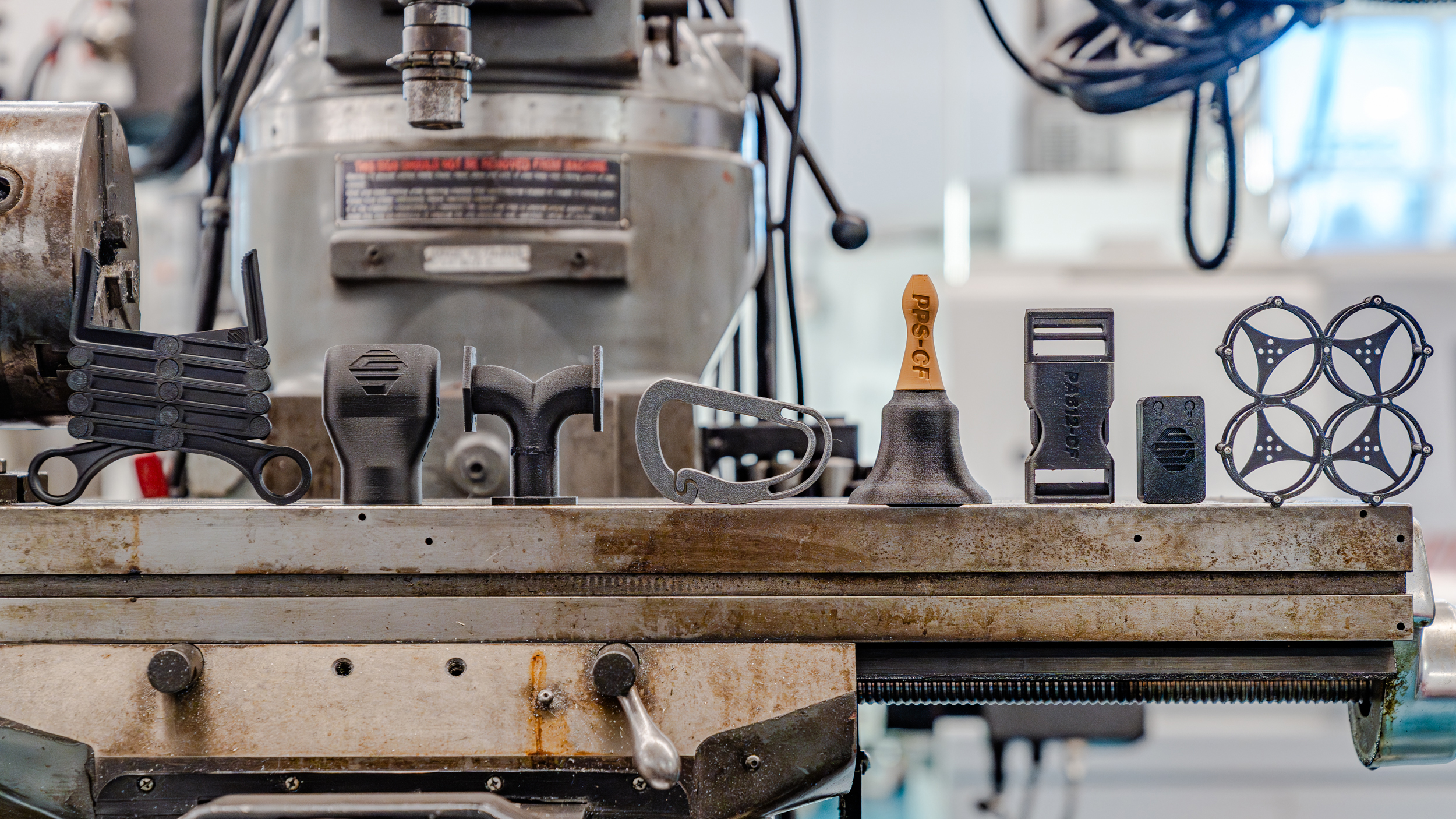
Extrusor direto:
Extrusor Bowden (indireto):
(Apenas se o material tiver absorvido humidade)
Mais informações e dicas sobre recozimento disponíveis na aba de FAQ.
Não encontras o perfil da tua impressora? Junta-te ao nosso Discord e verifica se a comunidade já criou um!
Podes saber mais sobre o processo de recozimento AQUI.
O recozimento melhora significativamente a resistência térmica do PET-CF17, elevando a temperatura de deflexão térmica (HDT) de cerca de 70 °C para mais de 100 °C.
Contudo, em termos de propriedades mecânicas, o recozimento aumenta sobretudo a rigidez (módulo) do material, sem melhorar a resistência ao impacto nem a adesão entre camadas. Ou seja, o material não se torna mais resistente após o recozimento.
Se a tua peça tiver secções muito finas, o recozimento a 120 °C pode causar deformações. Nestes casos, sugerimos três possíveis soluções:
Sim! Redesenhámos as extremidades das nossas bobinas para que todos os produtos Polymaker funcionem perfeitamente com o AMS.
No entanto, deves ter cuidado ao usar materiais abrasivos no AMS.
PET e PETG diferem na estrutura química, nas propriedades, na facilidade de impressão e nas aplicações:
É possível imprimir este material sem um secador de filamento, mas isso depende muito da humidade do ambiente onde estás.
Se vives num clima húmido, pode ser necessário usar um secador durante toda a impressão ou entre impressões.
Guarda sempre o filamento em ambiente seco.
Infelizmente, não oferecemos bobinas de 1 kg do Fiberon™.
Isto deve-se à maior probabilidade de o filamento de fibra de carbono ou fibra de vidro se partir na bobina, devido à sua maior fragilidade.
Para minimizar este risco, utilizamos uma bobina com núcleo maior — o que faz com que 1 kg de filamento não caiba numa bobina tradicional de 1 kg.
500g- Rolo
Fiberon PET-CF17 - Black
1.75mm (+-0.05mm) - Espessura / Tolerância de diâmetro
280º a 300º - Temp. recomendada do Hotend
40º a 50º - Temp. recomendada da Heated bed (0ºC mediante aplicação de 3DLAC)
Fácil - Facilidade de Impressão